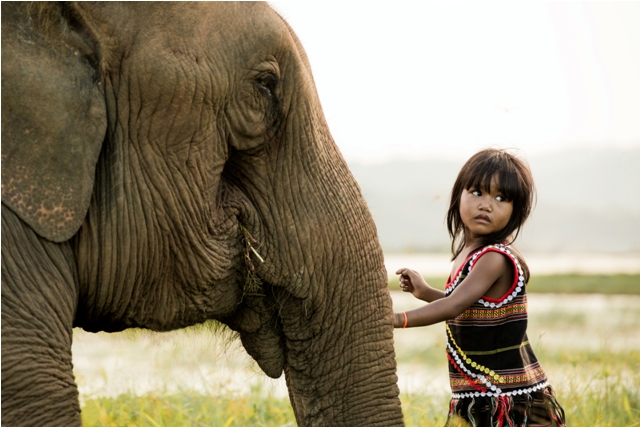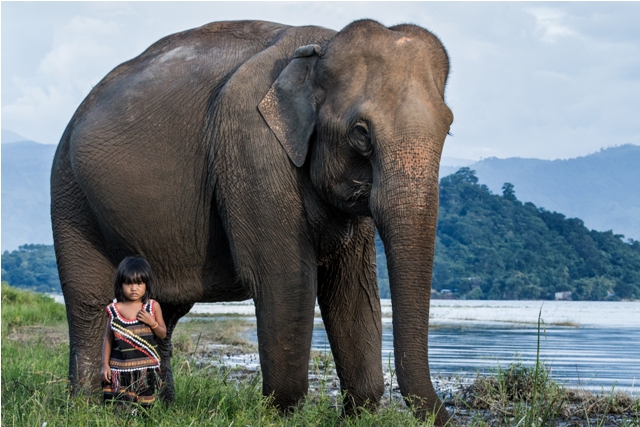The M'nong people live with and have close bonds with elephants.
They are famous for their skills in controlling and taming elephants, a dangerous and difficult job. Elephant hunters need not only special skills to overcome the challenge of catching the elephants but also to overcome the difficulties in the jungle.
Wild elephants are captured when they are very young and then raised as pets. Once tamed, elephants play an important role in the daily life of ethnic people and also become an important means of transportation for the M'nong people.

Traditionally, elephants are symbols of war. Village elders often tell wonderful stories of elephants assisting in battles, overwhelming enemies. Therefore, elephants are not only considered a means of work but also have become an enriching part of the lives of the M'nong people for generations.

Elephant Protection Law
According to the Elephant Protection Law issued by the M'nong people, when elephants are not healthy, it is the villagers' duty to take care of them. It is both a duty and a privilege.
Those who trespass or eat elephants will be punished. Those who kill elephants for economic or profit purposes will be severely punished. Different levels of crime will be dealt with in different ways. Those who abuse elephants too much will have to pay a fine of a cow or another elephant.
The law applies to both humans and elephants. If for any reason an elephant harms or kills a human, the elephant will be killed. The village chief holds a hearing to discuss the laws with the villagers, and depending on the specific situation, the appropriate punishment will be enforced.
Elephant health prayer ceremony
In Lien Son town (La81k district, Dak Lak province), every year people hold a ritual to pray for the health of elephants throughout January. This custom has existed for more than a thousand years. The time of the ritual depends on the health condition of the elephants and the decision of the owners. Participants in this event often bring wine and a pig as gifts for the elephant owners.

The number of elephants in the country is alarming.
According to 2005 statistics, the number of elephants in the country has decreased sharply from 600 in 1980 to 165 in 2005 (Source: eleaid.com). This alarming figure shows the importance of protecting elephants, and at the same time sets an inevitable requirement to increase the number of elephants again. Elephants play an important role in the culture and heritage of the M'nong people, so the sharp decrease in the number of elephants means the loss of cultural heritage and national identity.
The story of Kim Luan, 6 years old
This photo symbolizes the respect the M'nong people have for elephants. Taken in 2014, the photo has been published in publications in over 40 countries as well as in many world-famous magazines such as Time Magazine and National Geographic.

What makes this photo special is the contrast between the small girl and the large wild creature. Fun fact, I couldn’t get close to the elephant but little Kim Luan could.

The good news is that the Dak Lak provincial government is determined to protect the elephant population as well as the customs of the M'nong people. The government wants to preserve the relationship between humans and elephants, gradually protecting the cultural traditions of this ethnic group.
----------------------
The 6th Buon Ma Thuot Coffee Festival and the Central Highlands Gong Culture Festival 2017 will take place from March 8-13 at many locations in Buon Ma Thuot City and Buon Don District.
----------------------
More information:
+ M'nong people:In 2009, the M'nong population was 102,741 (Wikipedia). They live mainly in the mountainous areas of Dak Lak, Dak Nong, Quang Nam and Lam Dong. Additionally, a small group of M'nong live in Cambodia.
+ Culture:The M'nong have a rich collection of myths and legends. They are polytheistic. They have a tradition of playing musical instruments, including various gongs and flutes. The M'nong enjoy a wide variety of jewelry, including necklaces, bracelets, earrings, and gold rings.
+ Village:M'nong villages are called "buon". Each village has more than 20 families who are closely connected to each other, creating the community strength of the village. They build stilt houses, roofs covered with dry grass, door frames made of bamboo and wood. They often live in areas near valleys, lakes and streams close to nature.
+ Economy:The M'nong people cultivate slash-and-burn agriculture. Those who live near rivers often grow rice.
According to Mr. Ama Phong - a M'nong Riam in Lac district - the ancient M'nong people did not cultivate fields. They fished and grew rice. He said the traditions and customs of the M'nong people are very similar to those of the Ede people. The main difference is the language between the two ethnic groups.
+ Cuisine:Corn, cassava, potatoes, and rice are the staple foods of the M'nong. They like sour foods like bamboo shoots and fish sauce, pickled fish, shrimp, and buffalo meat. Food is often marinated and stored for a long time so that it can be used throughout the season.
Article and Photos: Rehahn C
------------------
About the author:
------------------
 French photographer Réhahn C. has spent 6 years in Vietnam, and is currently living and working in Hoi An. The photos of the M'nong people in Dak Lak selected to be introduced here are a small part of a collection of more than 200 photos of cultural heritage and more than 30 types of ethnic costumes among the 54 ethnic groups in Vietnam. They are currently kept and displayed at The Precious Heritage Gallery Museum (7 Nguyen Hue, Hoi An) founded and managed by Réhahn himself.
French photographer Réhahn C. has spent 6 years in Vietnam, and is currently living and working in Hoi An. The photos of the M'nong people in Dak Lak selected to be introduced here are a small part of a collection of more than 200 photos of cultural heritage and more than 30 types of ethnic costumes among the 54 ethnic groups in Vietnam. They are currently kept and displayed at The Precious Heritage Gallery Museum (7 Nguyen Hue, Hoi An) founded and managed by Réhahn himself.


































